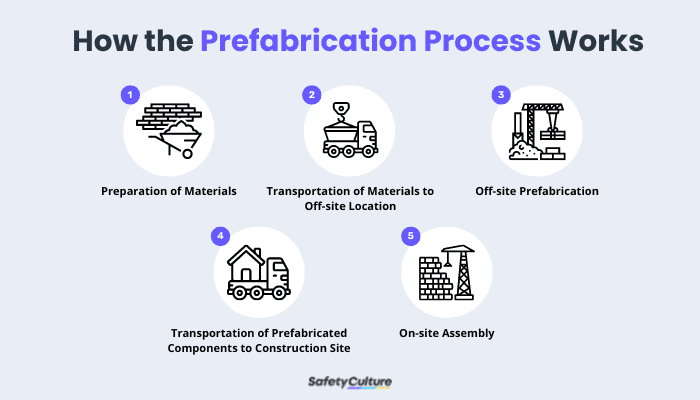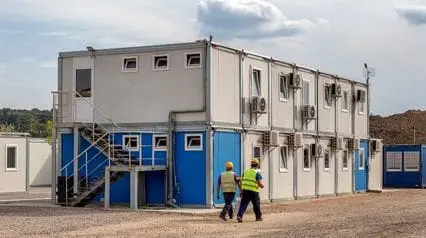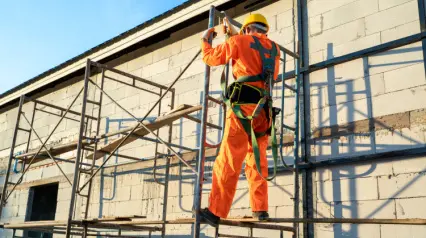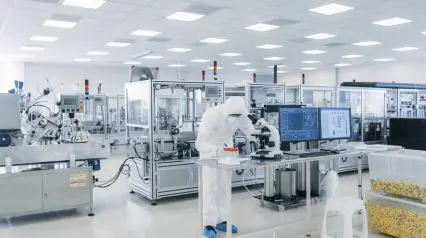What is Prefabrication?
Prefabrication refers to the practice or method of assembling buildings or components of structures at a location different from the construction site, such as a factory or any other manufacturing site. The process also involves transporting either complete assemblies or sub-assemblies to the construction site.
Prefabrication vs. Modular Construction
Prefabrication is an umbrella term that encompasses various types of pre-assembled structural components. One of these is modular construction, a type of building design where each space or room is built separately through prefabricated modules. Hence, it must be noted that all modular structures are prefabricated, but not all prefabricated structures follow the concept of modular construction.
What are the Advantages and Disadvantages of Prefabrication in Construction?
Considered a construction innovation, prefabrication undoubtedly presents many advantages and disadvantages depending on the needs and expectations of project managers, contractors, and building owners as well as the capacity and productivity of laborers.
Here are some of the top pros and cons of prefabrication:
Advantages
- Cost-effective – In most cases, transporting partial structure assemblies from a factory or manufacturing site incurs lower costs compared to transporting raw materials and resources to each site.
- Quality control – The added equipment and tools for assembling structures before they are transported to the site itself help improve quality assurance and quality control.
- Reduced environmental impact – Off-site prefabrication of components and structures can result in reduced pollution, job site disturbance, and disruption of flora and fauna.
- Improved safety – Since some or most of the structures are pre-assembled and transported to the construction site, the needed time frame to work on-site can be reduced, which can then impact worker safety positively. In relation to that, the construction site is less crowded, which would result in fewer injuries. It would also improve efficiency on-site because you have fewer materials in the way that have to be moved around.
Disadvantages
- Higher initial costs – This is because materials and resources need to be gathered for prefabricated structures and components along with the ones needed for on-site work.
- Challenging transport means – Prefabricated components may require heavy-duty machinery and equipment for transportation, which can be costly and risky.
- Shortage in skilled labor – This construction methodology requires qualified people to be involved in the design, production, and execution.
- Limited design flexibility – Prefabricated structures that are made using the same or similar types of materials can look monotonous.
How It Works

How the Prefabrication Process Works
Based on this study published on ResearchGate, a simple depiction of how the process of prefabrication works is as follows:
- Preparation of Materials – raw materials, equipment, and other resources needed
- Transportation of Materials to Off-site Manufacturing Plant or Factory – use of machinery to move materials and prepare for production
- Off-site Prefabrication – where the actual work of constructing modules or panels of structures is done at a location other than the construction site itself
- Transportation of Prefabricated Components to Construction Site – moving of prefabricated components to the construction site
- On-site Assembly – where the prefabricated components are integrated or installed into the structure or building on-site
Strategies
While more and more contractors are considering the prefabrication methodology, it’s best to understand its basic principles and some helpful strategies for its successful implementation. To guide you, here are a few tips and essentials to consider:
Don’t skip detailed planning.
A significant portion of the project’s success is dependent on how well-planned it is. Hence, contractors must ensure that all the project’s needs and specifications are clearly defined and which materials or components should be prefabricated.
Digitize the way you Work
Empower your team with SafetyCulture to perform checks, train staff, report issues, and automate tasks with our digital platform.
Get Started for FreeEstablish and adhere to key project components.
In any construction project, it’s crucial to understand what needs to be done and which part must be prefabricated or not. Even if it can improve productivity and efficiency, stakeholders should verify if this methodology can really help speed up the project and if it’s aligned with the project’s requirements.
Standardize what you can.
Moving forward, processes and activities involved in prefabrication must be streamlined and easier to reapply. Experience is key, which helps contractors identify the specific prefabrication techniques that can be replicated in future projects.
FAQs About Prefabrication
According to the US National Park Service (NPS), London carpenter H. John Manning conceived the possibly first ever advertised prefabricated home called “Manning Portable Cottage” in 1830. It was built component by component and then was shipped and assembled by British emigrants.
The 2 main types of prefabrication are modular and panelized. Modular construction, also called modular prefabrication, covers three-dimensional (3D), shop-assembled panels. Panelized prefabrication, on the other hand, refers to two-dimensional (2D) components assembled together on-site to form a building.
Prefabrication refers to the off-site production and/or pre-assembly of construction components before transporting them to the construction site. Precast construction, on the other hand, involves a type of concrete that’s mixed, cast, and cured off-site (e.g., factory) through reusable molds, which can then be connected or integrated to form a complete structure.
The materials typically used for prefabrication structures include concrete, steel, wood, glass, recycled and reclaimed materials, aluminum, and plastic. In some cases, cellulose insulation, ceiling tiles, and ceramic or porcelain tiles are used to construct prefabricated homes.



